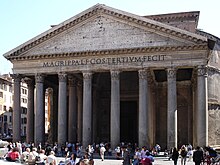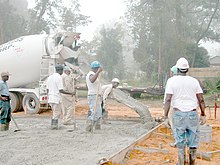
Back Tembok ACE Beton Afrikaans Beton ALS Fornigón AN خرسانة Arabic بيطون ARY Formigón AST Beton Azerbaijani Бетон Bashkir Bedau BAR




Concrete is an important material for making different buildings and structures. It is a composite made of Portland cement, sand, gravel or rock aggregate, and water. The amount of each can change depending upon what the concrete will be used for.
Concrete is used more than any other man-made material in the world.[2] As of 2006, about 7.5 billion cubic meters of concrete are made each year—more than one cubic meter for every person on Earth.[3]
The ingredients are mixed together into a paste, a bit like making dough for bread. The concrete is then poured into a frame. After a few hours it sets hard. Concrete solidifies due to a chemical reaction known as hydration. The water reacts with the cement, which bonds the other components together, eventually creating a strong stone-like material.
Concrete is used to make pavements, pipe, architectural structures, dams, foundations, motorways, bridges, multi-story parking, walls, footings for gates, fences and poles and even boats. Its biggest advantage is that it bonds together bricks and stones better than any other method known to mankind.
Concrete is strong in compression but weak in tension. For some purposes it needs to be reinforced with steel rods. Reinforced concrete buildings can be made to link all the parts together, the foundations, walls, floors and roofs, but concrete construction does not make buildings earthquake-proof.
- ↑ The Roman Pantheon: the triumph of concrete
- ↑ Lomborg, Bjørn (2001). The Skeptical Environmentalist: measuring the real state of the world. p. 138. ISBN 978-0-521-80447-9.
- ↑ "Minerals commodity summary – cement – 2007". United States Geographic Service. 1 June 2007. Retrieved 16 January 2008.
© MMXXIII Rich X Search. We shall prevail. All rights reserved. Rich X Search